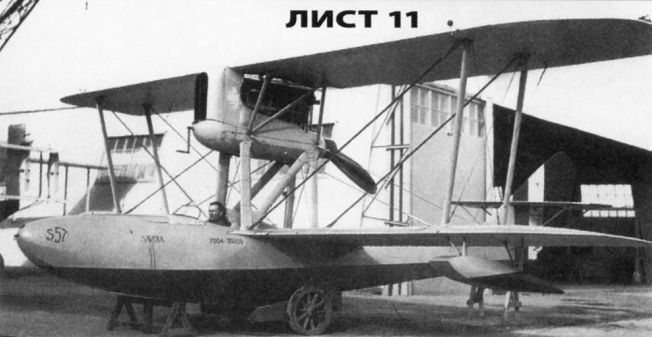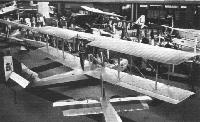
Описание
Страна : Италия
Год : 1923
Летающая лодка
Летающая лодка, бомбардировщик и разведчик
Варианты
- SIAI - S.16 / S.53 - 1919 - Италия
- Savoia-Marchetti / SIAI - S.57 / S.58 / S.59 - 1923 - Италия
- Savoia-Marchetti / SIAI - S.62 / МБР-4 - 1926 - Италия
Savoia-Marchetti S.57 и S.59
Летающая лодка-разведчик S.57 имела однореданный корпус и деревянную конструкцию. Пилот и стрелок-наблюдатель размещались в тандемно расположенных открытых кабинах в носовой части. На самолет был установлен 250-сильный (186 кВт) ПД Isotta-Fraschini V6, а вооружение состояло из единственного 7,7-мм пулемета Fiat на кольцевой турели над кабиной наблюдателя.
Два прототипа были построены в 1923 году. Экспериментальный S.57bis был оснащен 300-сильным (224 кВт) ПД Hispano-Suiza 42. Размах крыла S.57 составлял 11,25 м, максимальная взлетная масса - 1605 кг, а максимальная скорость - 215 км/ч.
Самолет S.59, прототип которого взлетел в 1925 году, создавался как дальнейшее развитие летающей лодки S.16 и должен был использоваться в качестве разведчика и бомбардировщика эскадрильями морской авиации итальянских ВВС.
Экипаж самолета S.59 размещался в двух расположенных рядом открытых кабинах перед крылом, а также в нижней кабине с пулеметом Lewis на подвижной установке.
Так как мощность установленного на прототипе 360-сильного (268 кВт) мотора Rolls-Royce Eagle была недостаточной, на первые серийные самолеты устанавливали 400-сильный (298 кВт) ПД Lorraine-Dietrich 12Db. Учитывая ограниченные характеристики машин с этой силовой установкой, в 1926 году для итальянских ВВС построили только 40 S.59. В том же году один S.59, получивший имя "Buenos Aires", совершил перелет из Нью-Йорка в Буэнос-Айрес.
Самолет S.59bis 1927 года выпуска отличался от предшественника только более мощным двигателем Isotta-Fraschini Asso 500 и строился большими сериями как самой фирмой "Savoia-Marchetti" (82 машины), так и фирмами CANT (50) и Macchi (50). Поставки этих летающих лодок завершились к 1930 году.
Этим самолетом были вооружены, как минимум, пять эскадрилий итальянских ВВС. В 1928 году 51 летающая лодка S.59bis составила основу очень эффектной авиагруппы, совершившей круиз по западному Средиземноморью.
В 1930-х годах многие S.59bis получили предкрылки Handley Page на верхнем крыле. После вывода из состава боевых частей в 1937 году машина еще долгие годы использовалась в качестве учебной.
Лодки S.59bis поставлялись на экспорт в Аргентину (10 самолетов) и в Румынию (восемь). Гражданский вариант S.59P, созданный в 1928 году, получил закрытую кабину в носовой части для четырех пассажиров и двух членов экипажа.
ТАКТИКО-ТЕХНИЧЕСКИЕ ХАРАКТЕРИСТИКИ
Savoia-Marchetti S.59bis
Тип: летающая лодка, бомбардировщик и разведчик
Силовая установка: один рядный ПД Isotta-Fraschini Asso 500 мощностью 510 л. с. (380 кВт)
Летные характеристики: максимальная скорость 200 км/ч; потолок 4550 м; продолжительность полета 5 ч
Масса: пустого снаряженного 1950 кг; максимальная взлетная 2950 кг
Размеры: размах крыла 15,50 м; длина 10,36 м; высота 3,50 м; площадь крыла 60,00 мг
Вооружение: один 7,7-мм пулемет Lewis и до 280 кг бомб на внешней подвеске
Описание:
- Savoia-Marchetti S.57 и S.59
- Flight, April 1925
THREE "SAVOIA" SEAPLANES - Flight, July 1925
THE SAVOIA S.52 AND S.58 BATTLE 'PLANES - Flight, October 1928
Berlin Aero Show 1928
Фотографии
-
Мировая Авиация 230
В 1925 году 18 S.57 были поставлены итальянским ВВС, использовавшим их для обучения. Часть самолетов попала в строевые эскадрильи для ознакомительных полетов.
-
Flight 1925-04 / Flight
Side view of the Savoia S.57 fast reconnaissance flying boat fitted with a 300 h.p. Hispano-Suiza engine.
-
Air International 1992-12 / Fighter A to Z
The SIAI S.58 single-seat fighter flying-boat
-
Flight 1925-07 / Flight
THE SAVOIA S.58: Side view of the single-seater fighter flying boat.
-
Flight 1925-07 / Flight
THE SAVOIA S.58: Three-quarter front view of the single-seater fighter flying boat, fitted with 300 h.p. Hispano-Suiza.
-
Мировая Авиация 230
Десять S.59bis использовались аргентинскими военными в 1927-1935 годах. На них стояли 450-сильные (336 кВт) ПД Dietrich, а вооружение включало два 7,65-мм пулемета и четыре 12-кг бомбы.
-
Jane's All the World Aircraft 1980 / Encyclopedia of Aviation - Aircraft A-Z - v5
Savoia-Marchetti S.59.
-
Flight 1928-10 / Flight
The Italian Flying-Boat: View from above of the Savoia S.59.
-
Aviation Historian 32 / M.Wickstead - Italy's forgotten airlines (2)
Регистрационный номер: I-AACO SIAI-Marchetti S.59P I-AACO (c/n 9566) joined the SAM fleet from AEI in late 1934.
-
Flight 1925-04 / Flight
Savoia S.57b Reconnaissance Flying Boat 300 hp Hispano-Suiza Engine
-
Flight 1925-07 / Flight
Savoia S.58 300 hp Hispano-Suiza Engine
- Фотографии










